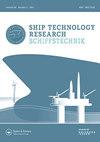Hydrodynamic hull form optimization of fast catamarans using surrogate models
IF 0.9
Q3 ENGINEERING, MARINE
引用次数: 20
Abstract
ABSTRACT This paper demonstrates the practical benefit of using efficient computational methods to optimize fast catamarans hydrodynamically. The development of a simplified panel method, which is based on thin ship theory, and the validation of the associated code for the prediction of the calm water resistance of twin-hull vessels is presented. The method was applied in the multi-objective optimization of a fast, zero-emission, battery-driven catamaran by a genetic algorithm, while considering the ensuing design constraints. Results of the study were compared with resistance predictions from a non-linear Rankine panel method and a viscous CFD solver. Moreover, surrogate models were implemented to speed up the optimization process involving several hundred parametrically generated designs. The proposed simplified panel method in connection with a empirical correction for the stern flow proved very valuable in the resistance prediction and hull form optimization of fast catamarans and of slender hulls in general.基于代理模型的快速双体船水动力船型优化
摘要本文证明了使用有效的计算方法对快速双体船进行水动力优化的实际效益。提出了一种基于薄船理论的简化面板法,并对双壳船静水阻力预测的相关代码进行了验证。将该方法应用于快速、零排放、电池驱动双体船的遗传算法多目标优化,同时考虑了随后的设计约束。将研究结果与非线性朗肯面板法和粘性CFD求解器的阻力预测进行了比较。此外,还实现了代理模型,以加快涉及数百个参数生成设计的优化过程。所提出的简化面板法与船尾流的经验修正相结合,在快速双体船和细长船体的阻力预测和船体形状优化方面被证明是非常有价值的。
本文章由计算机程序翻译,如有差异,请以英文原文为准。
求助全文
约1分钟内获得全文
求助全文

 求助内容:
求助内容: 应助结果提醒方式:
应助结果提醒方式:


